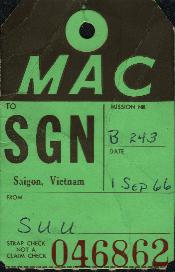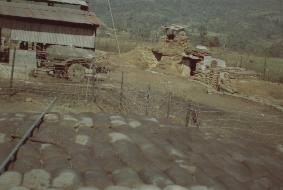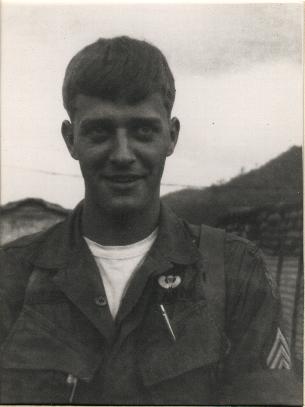Besides the hazards of an armed conflict, Viet Nam held many surprises for the US troops. One such surprise
lay within the country itself.
In another web page I mentioned that Viet Nam was a beautiful country -- rugged mountains guarded by a high plateau with sometimes
near-vertical walls... and river valleys, lush and green. The farmers, tending their rice paddies, used the same methods
used by many generations before them. It painted a serene, pastoral picture. But danger lurked everywhere in Viet Nam. No,
I'm not talking about the dangers inherent within an area of armed conflict. I'm talking about dangers at the microscopic level.
Viet Nam was, by Western standards, an unsanitary place. Perhaps this situation was aggravated by totally different perspectives
on things. Consider the following example.
The government was rapidly building up the number of the US ground forces in the mid-1960's. Of course, when you want to deploy
personnel in the fastest amount of time, you transport by air. So it was with the Army. The US military hired commercial
airline companies to transport soldiers to Viet Nam. I departed the US on a chartered Branif Airlines flight -- a 23-hour flight.

To my knowledge most Army personnel with orders for Viet Nam were processed by either the Oakland (CA) Army Terminal or by Fort Lewis (WA).
Commercial airliners, chartered by the military were used to transport the soldiers to Viet Nam. Flights originating from
San Francisco had a stop-over for fuel at Hawaii. Flights departing Fort Lewis used the polar route, with a fuel stop-over in Japan. While
processing at the Oakland Army Terminal we were restricted to base. We did not bother to ask for special permission to enjoy the sights,
sounds, and other pleasures of that small community across the bay (San Francisco). Our philosophy was: "What are they going to
do to us? Put us in the Army and send us to Viet Nam?!?" I remember going to one nightclub in our Class A's. The
doorman would not let us in because we did not have ties on. It took three of us to hold 'Moose' back -- he wanted to kick ass! On
several mornings we were entering the barracks as the CQ was turning on the lights for the wake-up call. This dream world was over in
five days. We all had a date with reality.
The chartered flight approached [Ton Son Nhut] airbase at Saigon at a high altitude (to avoid ground fire) and entered
the landing pattern at a sharp angle. Once on the ground we deplaned and went into the terminal. In another page I explained that a
woman came into the men's restroom and pissed into the floor drain.
This was my first experience with a different culture. Indeed, this was my first ten minutes 'in-country'! It never dawned on me that not
everyone does things the way we (Americans) do them. Their ideas about sanitation were just one facet of this difference. It was
not unusual to see pedestrians in the larger cities (such as Da Nang) stop and urinate on the street. What was the big deal??? I mentioned
elsewhere that A-Team members helped construct outhouses for the villagers -- only to find out that they didn't know what to do with them. We
had to teach them how to use the latrines (outhouses).
The Water Problem
In the outlying areas things were less 'sophisticated'. They had no running water... no indoor plumbing. Their farm animals were
allowed to wander freely... and to leave their droppings wherever they plopped. The people bathed in the river; they did their wash
in the river. The animals frequently lounged in the river -- especially the water buffalo.
The Army had its 'water buffalo', also. Our 'water buffalo' referred to a large water tank mounted on a trailer. Even today, you will
find these mobile canteens used to carry drinking water to people when normal water supplies are unavailable. Emergency services
often use these 'water buffalos'.

The Gia Vuc mobile water carrier (AKA "water buffalo") sits parked next to the building. To my knowledge all SF camps
used these trailer-mounted tanks to transport/store camp water for bathing and drinking. Periodic trips to the river ensured that
we would have a supply of water. Camps did not have provsions for water treatment.
Our camp used a water buffalo to transport and store water. We would hook the jeep up to the trailer and go down to the river for a
refill. We tried to be judicious about our water pickups. We made every effort to be upstream from the real water
buffalos. Apparently, we were not always successful.
One of the results from the water problem
The team members at Thuong Duc (A-109) suffered from dysentery frequently. I am not just talking about upset stomachs; we are talking
seriously sick people. The symptoms included severe diarrhea and severe nausea. If these symptoms continued for an extended
period of time, they could be life-threatening. One of the consequences of these symptoms is severe dehydration. We were really short-handed
one time, so we sent one of the men (who had dysentery) on patrol. After two-and-a-half days we had to bring the patrol back in. The
man was getting so weak that we feared he couldn't make it back to camp if his return were delayed much longer. [I believe that Sgt
Peters, the medic, was the individual.]
I remember a time when I had a bad case of dysentery. I felt terrible. The nausea was overwhelming. I told Peters that I thought I would
feel better if I could 'throw up'. Peters had nothing in the medicine cabinet, so he told me to go up to the teamhouse. I was to fill an
8oz glass three-fourths full of mustard and add water to fill the glass. I was instructed to drink this mixture. Peters said something
to the effect that "...I'm sure that will do the trick." I never did throw up, but it did settle my stomach!
It is difficult to find the 'polite' words to convey how sick we were at times. There were many instances when a member would bolt for
the outhouse... only to have to change his destination to the shower instead of the outhouse. You just wouldn't make it to the latrine!
Basically, the water everywhere in Viet Nam was filled with tiny, microscopic timebombs called germs. Rice paddies, filled with mud and animal
dung, were flooded to make the rice grow. The water would leak from these rice paddies and flow into tributaries, spreading the germs into
drinking water sources. On patrol we had [Halizone] tablets. We would fill our canteens out of a stream, place three tablets in the
canteen, shake a couple times, and put the canteen away. In an hour or so we could drink the water. Sure, it tasted like crap (pardon the pun!) ==
but it was safe to drink!
It was quite common for US troops to lose twenty to thirty pounds when they arrived in-country. Bad water and dietary changes caused most of
the weight loss.

On the way down...
I arrived at Gia Vuc as a 6-foot, 180 pound soldier. I soon found myself down to 150 pounds -- due primarily to the lack of a good diet and bad
water. The physical strain of the patrols also tended to reduce each soldier's weight. The periodic bouts with dysentery and low body weight
reduced our ability to sustain a long term, high-level engagement.
It is strange that you did not perceive yourself as also being affected by these factors. I did not sense that my physical condition had
deteriorated. Yet, I saw these symptoms when I looked at the other men. Lt Carter was a good example. Although I do not know for certain,
I guess that this man was 6 feet, 4 inches tall. But my guess at his weight (when we were in Gia Vuc) would put his weight at 175 pounds.
<< This picture was probably taken around March 1967. I had been promoted to E-5 by this time.
